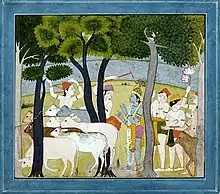Gopala-Krishna
Gopala-Krishna (Sanskrit: गोपाल Gopāla, literally "cow protector" but sometimes also, "protector of the world" "Go"-world, "pāla"-protector, again in very seldom cases, "Favourite of God" where "Go"-Universal Gods and Goddesses or Universal Mother, "pāla"-affectional adjective, or in a more primitive, direct sense, according to atheist ideas, "One who protects anyone in the ongoing journey of completing the great circle" "Go"-round, "pāla"-protector, See Samkhya Upanishad. But the basic meaning will be "cow protector") is the infant/child form(name) of Lord Krishna, the Cowherd Boy who enchanted the Cowherd Maidens (Gopinis) with the divine sound of his flute, attracting even Kāmadeva (the Hindu god of love and passion). Historically one of the earliest forms of worship in Krishnaism or Vaishnava dharma, it is believed to be a key element of the early history of the worship of Krishna. This tradition is considered separately to other traditions that led to amalgamation at a later stage of historical development. Other traditions are Bhagavatism and the Cult of Bala Krishna, that along with the Cult of Krishna-Vasudeva form the basis of the current tradition of the monotheistic religion of Krishna.[1]
_as_Infant_Krishna_-_Walters_543081.jpg.webp)

See also
References
- KLOSTERMAIER, Klaus K. (2005). A Survey of Hinduism. State University of New York Press; 3 edition. pp. 206. ISBN 0-7914-7081-4.
Present day Krishna worship is an amalgam of various elements. According to historical testimonies Krishna-Vasudeva worship already flourished in and around Mathura several centuries before Christ. A second important element is the cult of Krishna Govinda. Still later is the worship of Bala-Krishna, the Divine Child Krishna - a quite prominent feature of modern Krishnaism. The last element seems to have been Krishna Gopijanavallabha, Krishna the lover of the Gopis, among whom Radha occupies a special position. In some books Krishna is presented as the founder and first teacher of the Bhagavata religion.
